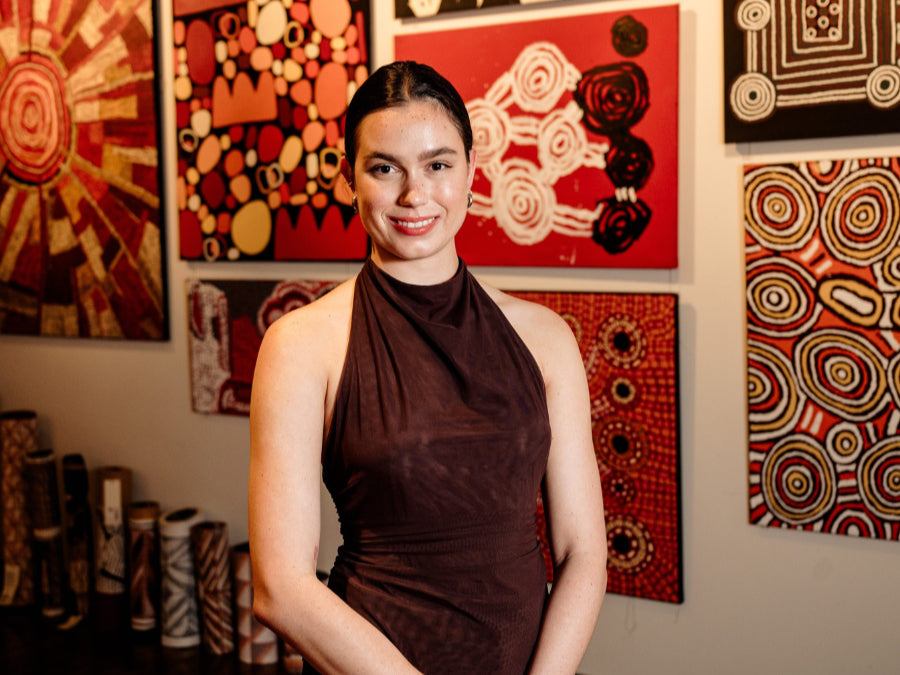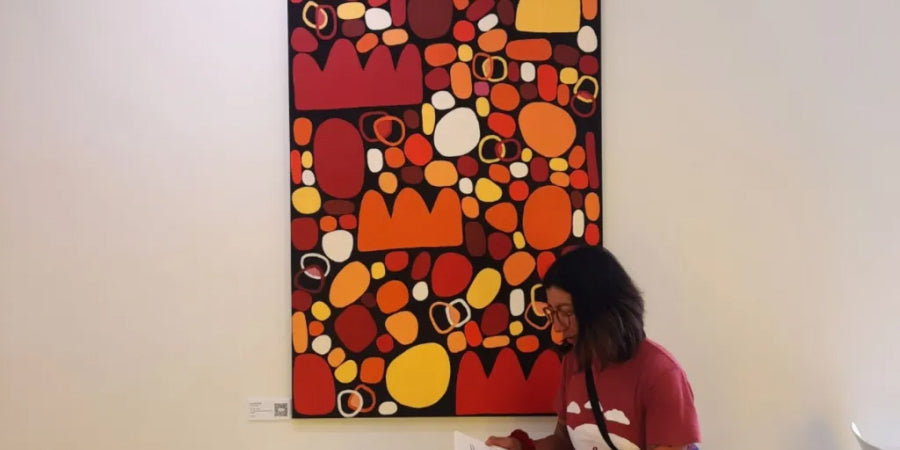Arabella Walker | Seasonal

An exploration of fire and wet-hot, dry-hot, wet-cold, dry-cold climates on Wulli-Wulli Country, west of Bundaberg in Queensland.
Arabella Walker is from the maternal lineage of Wulli Wulli, the Auburn Hawkwood people. She stands as an emerging contemporary Aboriginal artist, utilising her art to delve into First Nation histories. Stepping forth from a dance background, Walker seamlessly integrates multidisciplinary, interdisciplinary, and transdisciplinary approaches within her artistic journey. Currently in her final year of studies in a Bachelor of Contemporary Australian Indigenous Art (CAIA) at Queensland College of Art, Griffith University, Arabella is driven by the research linked to her personal history.
In June, Arabella Walker set herself up in the Aboriginal Art Co studio as our third Artist-in-Resident. For 8 weeks, Arabella has dedicated herself to create new works in the Aboriginal Art Co studio as a part of the Safe Space Artist Residency, supported by Brisbane City Council through the Lord Mayor’s Creative Fellowship. Having a dedicated space to work from Arabella was able to create her largest pieces to date. During the residency Arabella also visited the State Library where she learned more about the vegetation on Wulli Wulli and found more resources on her family history.
Seasonal delves deep into characteristics within the seasons of Wulli Wulli Country. Different from the seasons that are typically used in Australia (Summer, Autumn, Winter and Spring) Arabella chose to research and develop her own seasons which better reflect the climate and weather patterns of Wulli Wulli Country. Through her research Arabella identified seasons which she calls: wet-hot, dry-hot, wet-cold, dry-cold and while it is not a season Arabella also features fire as it was used as an important land management tool.
The Downpour explores the wet-hot season. Arabella describes this painting as depicting a ‘hot, steamy afternoon downpour that has soaked into the earth, creating a warm humid environment’. This painting also features a lot of movement with Arabella capturing water pooling and the migration of the water as it heads towards Auburn River. With great attention to detail Arabella has picked out colours from Country – greens from the vegetation growth, warm browns for the earth but also from the heat, blues for the rain and Auburn river, even white for the water vapor on those steamy afternoons are seen represented in this work.
Wildflowers Gone Wild is an exploration of the plants and flowers that flourish in the ‘inbetween’ of the wet-hot and the dry-hot seasons. Showcased are flowers native to Wulli Wulli Country including the Waxlip orchid, Velvet wattle, Wonga vines, Grevillea longistyla. For this explosion of flowers Arabella considered the silhouettes of flora and the colours of vegetation throughout stages of maturity.
Patchwork, the largest painting featured in this exhibition, highlights the use of fire as a tool. This painting shows us a birds eye view of Country and shows us how fire is used as a land management tool. This type of land management known as patch work, helps balance the ecosystem and encourages new growth. The colours used in this painting are very representative of fire even capturing glimpses of blue that is often seen in hot flames.
Arabella paintings contain layers of movement and bold colours inspired by weather patterns, hues, atmospheres, vegetation, tones, and textures on Country. The large scale paintings featured in Seasonal, transcends you to Wulli Wulli Country giving you a on Country experience. This exhibition give people a new perspective on Country and Arabella encourages the audience to ponder how Country is going to change in the future.
Blog written by Logan Bobongie, 2023.


